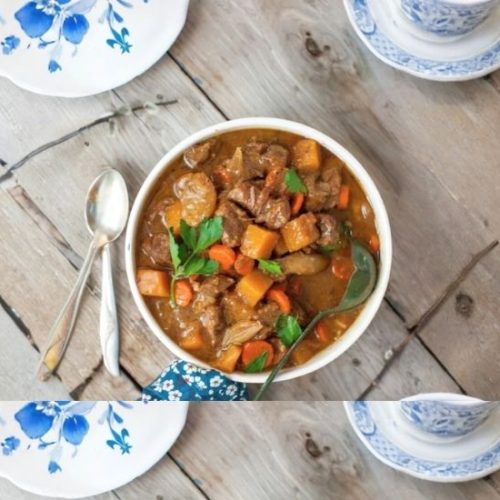
Classic Beef Stew with Root Vegetables
A classic slow-braised beef stew featuring tender chunks of beef cooked with rutabaga, carrots, shallots, and onions in a savory broth enriched with herbs, Dijon mustard, and Worcestershire sauce. This hearty, comforting dish is perfect for family meals or batch cooking and serves beautifully with crusty bread or mashed potatoes.
Equipment
- 1 Large Dutch Oven (3.5 qt)
- 1 Pair of Tongs
- 1 rubber spatula
- Measuring cups and spoons
- 1 Chef’s knife
Ingredients
- 2 pounds beef stew meat cut into bite-sized pieces
- ⅓ cup all-purpose flour
- 1 teaspoon fine sea salt plus more to taste
- 1 teaspoon freshly ground black pepper plus more to taste
- 3 tablespoons olive oil divided
- 3 teaspoons salted butter divided
- 3 cups beef broth separated
- ⅓ cup red wine or beer optional, for added depth
- 6 French shallots peeled and halved
- 2 small onions peeled and quartered
- 1 teaspoon fresh thyme leaves or 1/2 teaspoon dried thyme
- ½ teaspoon dried rosemary crushed
- 2 garlic cloves minced
- 1 pound rutabaga peeled and cut into 1-inch cubes
- 3 medium carrots peeled and sliced into rounds
- 1 teaspoon Dijon mustard
- 1 tablespoon Worcestershire sauce
Instructions
- Prepare and Coat the Beef: Begin by patting the beef cubes dry with a paper towel to remove excess moisture—this helps achieve a perfect sear. In a bowl, mix the flour with 1 teaspoon of salt and 1 teaspoon of pepper. Toss the beef pieces in the seasoned flour until they are evenly coated.
- Brown the Beef (First Batch): Heat 1 tablespoon olive oil and 1 teaspoon butter in a heavy-bottomed Dutch oven over medium heat until the butter is melted and foamy. Add half of the beef in a single layer, ensuring not to crowd the pan. Sear the meat on all sides until a rich golden crust forms, about 5-7 minutes. Remove browned beef to a clean bowl.
- Deglaze the Pan (First Time): Pour about 1/2 cup of beef broth into the hot pot and use a spatula to scrape up all browned bits stuck to the bottom. These flavorful bits are essential for the stew’s depth. Pour this deglazing liquid over the browned beef.
- Brown the Beef (Second Batch): Repeat the browning process with the remaining beef using the last teaspoon of butter and 1 tablespoon olive oil. After browning, deglaze again with the red wine or beer, scraping up all the caramelized bits. Transfer this to the bowl with the first batch of beef.
- Sauté Aromatics and Vegetables: In the same Dutch oven, heat 1 tablespoon olive oil over medium heat.Add shallots and onions and cook for 2 minutes until softened. Stir in thyme, rosemary, and garlic, cooking until fragrant.Add rutabaga and carrots, sautéing for 3 to 4 minutes until edges begin to soften.
- Thicken and Add Liquid: Sprinkle the remaining 2 tablespoons of seasoned flour over the vegetables and stir well to coat. Cook for 1 minute to eliminate the raw flour taste. Gradually pour in the remaining beef broth while stirring to avoid lumps, scraping the bottom to incorporate any stuck bits.
- Combine and Season: Return the browned beef and accumulated juices to the pot. Stir in Dijon mustard and Worcestershire sauce to enrich the flavor. The liquid should just cover the ingredients; if necessary, add a bit more broth or water.
- Slow Cook the Stew: Cover the Dutch oven with a tight-fitting lid and place it in a preheated oven at 275°F (135°C). Let the stew braise gently for 3 hours, allowing flavors to meld and beef to become tender.
- Final Cooking and Resting: Remove the lid and continue cooking uncovered for an additional hour to thicken the stew. Afterward, take the pot out and let the stew rest for about 15 minutes—the thickness will improve as it cools.
- Taste and Adjust Seasoning: Before serving, taste the stew and season with additional salt and freshly ground black pepper as needed.
Notes
- Browning is Key: Taking your time to brown the beef thoroughly in batches builds essential flavor—avoid overcrowding the pan to ensure even caramelization.
- Deglazing Choices: While red wine adds depth, you can skip it and use beef broth, beer, or even a robust apple cider for different flavor profiles.
- Butter Finish: For an extra touch of richness, stir in 2 tablespoons of butter once the stew is out of the oven. This adds silkiness and depth to the sauce.
- Vegetable Variations: Root veggies like parsnips or turnips can be swapped in for rutabaga or carrots to customize texture and taste.
- Make Ahead: This stew tastes even better the next day, making it perfect for meal prep or cozy leftovers.